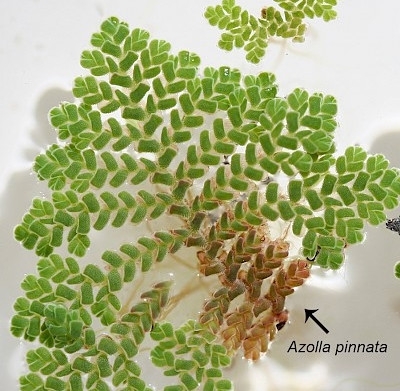There have been several recent questions about dealing with a plant floating in reservoirs. Here's Weed Scientist Emeritus Roncoroni's response to them.
* * * * * *
Pacific Mosquitofern, (Azolla filiculoides) often referred to as Azolla, is native to California. It is considered a desirable component of natural habitats and an important food source for waterfowl. Azolla is a floating aquatic fern that spreads by stem fragments and spores. Azolla as being up to 5cm (2 inches) long, but can be as small as ¼ to ½ inches.

Azolla becomes a problem when the population gets so high it begins to clog irrigation screens and pumps. It is reported that cattle won't drink from ponds that are covered with Azolla. One benefit of a dense population of Azolla is that it may actually block sunlight form hitting the pond and may keep other weeds and ‘algae' from growing. If Azolla is controlled the increased sunlight may allow these other weeds to become a problem.

How do you control an existing Azolla problem? Spraying Azolla with herbicides will have only limited success because each of the very small, plant must be treated. If you are successful in controlling a large infestation of Azolla serious degradation of water quality has been reported because of the large mass of rotting dead Azolla decomposing in the pond.
If you check on the web you will see that there is a weevil for sale that is supposed to control Azolla. The only problem for us is that this weevil (Stenopelmus rufinasus) is native to here! It has not been very effective in recent years. USDA researchers in Davis and Albany have been tracking the weevil. Temperature or other environmental factors may play a large part in the success of the weevil and the Azolla and its weevil may eventually regain their natural balance.
What do you do until then? The best recommendation I can give is to drag or rake the Azolla out of your pond. I have heard that some people will use a leaf blower to gather the Azolla in one corner of pond to make it easier to rake. What do you do with the Azolla once you rake it up? It is reported that Azolla makes an excellent ingredient in compost because of its nitrogen content.
Get the scoop on Azolla from "Weed Control in Natural Areas in the Western U.S."
To purchase a copy of Weed Control in Natural Areas in the Western United States, visit https://surveys.ucanr.edu/survey.cfm?surveynumber=32523.
Original source: Topic in Subtropics blog :: July 14, 2023